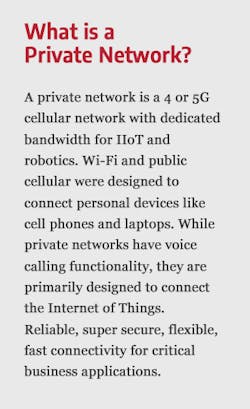A Look Ahead: 2023 Connectivity Trends for Smart Manufacturing
The global pandemic transformed manufacturing facilities. Unprecedented staffing shortages, supply chain disruption and an immediate need for simplified operations increased the demand for smart, connected environments.
Out of sheer necessity, 2022 became the year of digital transformation. Manufacturing executives were forced to adapt, and adapt they have. We’ve seen innovation at every level of the pipeline and priorities set to streamline operations and increase agility.
When it comes to manufacturing connectivity, smart business and intelligent factories, here are the 2023 trends to keep an eye on.
IIoT Delivers ROI
Industrial Internet of Things (IIoT) devices are hitting mainstream markets, and in 2023 there will be a focus on process automation—especially with the usage of robotics. IIoT tools are reported to increase productivity up to 160%. These connected applications open the door for widespread automation across operations, from assembly lines to inventory management.
When considering IIoT deployment, network bandwidth is the chief concern. Automation, via connected applications such as robotics, produce an immense amount of data and demand a lion’s share of network bandwidth. Gone are the days of completely powering a facility’s operations with public Wi-Fi access points or costly wired solutions.
The challenge is this: How to support scalable growth, where hundreds of wireless devices can seamlessly be added without impacting network and device reliability.
The solution is a dedicated private network. A closed-door network, designed strictly for operational needs, introduces increased bandwidth and coverage with layers of security.
Private networks hit the scene in a big way last year, moving from proof of concept to working deployments. They fulfill the need for cost-effective, quickly deployed coverage and secure bandwidth to support IIoT investments.
Networks Designed for Business Growth
While 5G is available today, the number of manufacturing applications it will power remains largely unknown. A recent Accenture study indicated 5G-enabled factories can see up to 20-30% in overall productivity gains, including improvements of 50% in assembly time, 20% in asset life and 90% in defect detection. 2023 is the year to create a 5G network backbone able to support the next decade of manufacturing and business growth.
The secret to success is starting with a secure network architecture designed to 1) grow with your business, and 2) work alongside existing and future technologies. 5G use cases for manufacturing include integrated safety and security management, equipment asset tracking and monitoring, connected utilities, logistics and supply chain management, autonomous vehicle and robotics operations, predictive line management and planned downtime. Serious bottom line savers.
A private network is optimal for critical use cases as it provides manufacturers with ultra-reliable, dedicated connectivity. Unlike a network running over Wi-Fi and shared by many users and applications, a private network can be configured with cellular technology to a manufacturer’s specific location, with total control, data insights and robust security. Moreover, a private network is wireless, responding to the obvious need for mobile, flexible factory floors.
Private networks are a great first step to support scalable and interoperable operations by creating a digital ecosystem where advanced factory floor technologies can communicate with each other and staff.
Data is the Decision Maker
Five years ago, The Economist headline read: “The world’s most valuable resource is no longer oil, but data.” Fast forward to present day and data is now the linchpin to successful business operations. Connected IIoT devices are producing petabytes of real-time data that manufacturing leaders can analyze to make critical decisions about operating efficiency, production performance, product design, employee workflows and more.
The chosen network model influences access to key data points. A private network can be configured to ensure business retains ownership of all data. Better yet, select network partners can customize dashboards for IT teams to easily see all desired statistics and alerts in one universal portal. In the coming year we’ll see enterprises of all sizes taking the next step to put the world’s most valuable resource at their fingertips.
Powering 2023 Operations
Digital transformation has arrived. 2022 introduced new connected manufacturing trials and use cases. As we kick off 2023, and the beginning of what’s possible for manufacturers, IIoT powered by 5G, and private networks will drive smart manufacturing into mainstream adoption. Now is the time to build your network to create the factory of the future.
Author Bio:
Michael J. Zeto III is a seasoned corporate executive and operator with a successful track record of leading high growth initiatives for emerging businesses. He currently serves as chief commercial officer at Boingo Wireless, where he is responsible for driving innovation across 5G, private networks, Wi-Fi 6, IoT and smart cities.Sponsored by:






